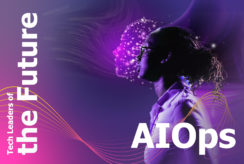In the dynamic world of IT management and digital transformation, CTO specialists navigate a myriad of challenges in establishing sound, enterprise architecture within organisations already hamstrung by legacy, often, outdated processes.
Read our interview with Wavestone Senior Manager and CIO/CTO Head for Asia, Romain Gagliardi, as he provides insights on core hurdles; from the demands of digital transformation to heightened cybersecurity concerns and how the pandemic had reshaped IT priorities, impacting the future of CIO/CTO services.
What do you see as a core challenge that CIO/CTO management will encounter/be responsible for in the coming years? How can they be better supported?
One of the core challenges CIO/CTO management will have to face is the increasing demand for digital transformation in organizations. IT leaders will be required to ensure the integration of new technologies including AI, Cloud Computing into the company’s operations and processes. We have already seen the emergence and power of AI through ChatGPT and the efficiency it can drive along with cloud computing will be a necessary requirement for businesses.
To be better supported, CIO/CTO management can benefit from having access to audits, training and resources that help them stay updated with the latest technology trends and advancement. IT business leaders require strong partnerships with technology vendors and service providers that can support their implementation and roll-out of solutions effectively.
These leaders must be proactive and open to change to fully gain strategic value from these technologies. Training & Technology vendors Partnership can be used to support CIO/CTO management to face those challenges.
In the past five years, what are some of the core obstacles/challenges faced within organizations that had to deal with uprooting or retooling their entire IT because of the pandemic?
Over the last five years and more specifically due to the challenges the pandemic brought, we have seen some of the biggest challenges that have forced IT leaders to embrace the retooling and restructuring of their IT assets.
With the big shift towards remote work, the IT assets that have had to see a big focus are: UCC, Technical Support and Data Privacy. Organizations have had to adopt new technologies like cloud computing, productivity trackers and collaboration tools to support this change.
This had led to additional technical support being required and stronger data privacy policies and procedures. We have also seen a big movement towards e-commerce/online sales.
All brick & mortar stores have had to develop an online presence to continue their business.
Would you say that cybersecurity from a CIO/CTO perspective is even more of an issue today than it was five to 10 years ago? What, in your opinion, affected this change and do you think organizations are educated enough about these changes and the risks involved?
What are some potential, new threats that may emerge in Industry 4.0?
(Industry 4.0 is the advancement of AI, IOT and Blockchain.) New advancement in technology also comes with new security risks and potential threats. Some may be similar to what we have seen before, but many will be new and more sophisticated.
We anticipate seeing higher level threats in Cybersecurity, Supply Chain disruptions and Job displacements. Additionally, with the use of AI, we may see a higher level of ransomware threats and privacy violations with the increased reach to new targets and the speed at which they can be targeted and harassed.
[For additional context: Job Displacement refers to the automation and digitization of industrial processes that will push low-skilled workers out of position and Supply Chain disruption refers to how a breach in one part of the chain can have a global impact with how complex and interconnected the Supply Chain industry it]
How can businesses in APAC leverage technologies like serverless computing, containerization and microservices to enhance their capabilities and drive innovation?
Businesses in APAC can leverage these emerging technologies to reduce costs and improve scalability of their organizations and services. Serverless computing can help reduce time-to-market by eliminating the need for infrastructure set-up and management.
Containerization can help improve the portability and scalability while reducing costs by using a shared infrastructure and reducing the overhead of virtualization. Microservices can help businesses improve agility, and resilience by enabling them to release new features independent of other organization services.
I follow a 5-step process to leverage these technologies. The steps are: Define a clear business objective, Assess the current state of the organization and applications, Identify the right technology, develop a roadmap, and execute the plan.
Do you agree that companies should decentralize their core IT functions into smaller, more agile outfits that can make quick, necessary changes?
Decentralizing core IT functions into smaller, agile services can benefit an organization with increased speed and flexibility in decision making allowing quicker responses to new business needs and market trends. However, this can also lead to creating a very separated and segregated tech landscape within an organization and isolating teams ultimately lowering consistency, security and compatibility.
In place of this, CIO/CTOs must find the best balance of a hybrid approach that involved centralizing IT functions like security, data management and infrastructure while allowing decentralized teams to manage specific projects and initiatives. This will help to combine the efficiency of a centralized IT function and the agility of a decentralized team.
Where do you see businesses moving in the next five years with regards to CIO/CTO services?
CIO/CTO services will always be at the forefront of an organization with the constant new developments in technology.
We anticipate seeing an increase in service requests particularly in areas such as: Cloud Computing, Data Analytics, AI, and Cybersecurity. Advisory services will help organizations stay ahead of the curve in terms of innovation and protection to support IT leaders in making informed decisions that drive growth and competitiveness.
With the continued rise of remote work, there will likely be an increased focus on digital infrastructure and security to support a distributed workforce.




